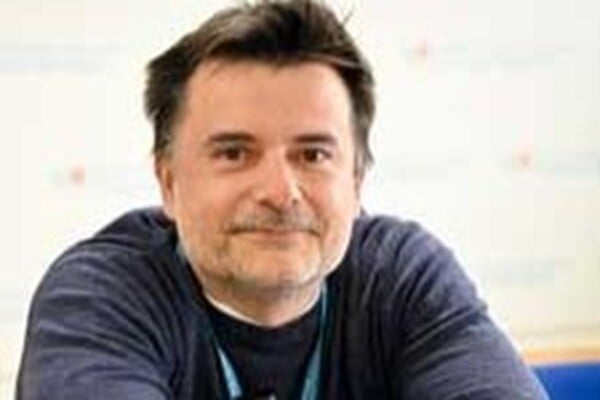- Customer Stories
- ECO-ARWEN Lung Cancer Project
How LOGEX Supports Data-Driven Insights in the ECO-ARWEN Lung Cancer Project

Interview with Dr. Víctor Cuadrado Martínez [1]
Interview with Dr. Víctor Cuadrado Martínez, Head of the Information Systems Department at Gregorio Marañón University General Hospital
Digitalisation and data analytics have transformed the approach to challenges in oncology, driving process optimisation and improving health outcomes through predictive models and advanced analytics. In this context, the ECO Foundation has played a key role in promoting the use of structured and unstructured data in oncology research, developing innovative initiatives such as the "ECO EVIDENCE" Evidence Generation in Oncology program. This program adapts to the data maturity of each participating hospital, establishing different types of projects based on the degree of data structuring and the nature of the hypotheses posed. A success story within this framework is the "ECO-ARWEN LC" project, which has enabled progress in the integration and exploitation of real-world data (RWD) in oncology, facilitating evidence-based clinical decision-making and enhancing collaboration between hospitals throughout Spain and Europe.
To delve deeper into this initiative, Rocío Casado Seminario, European Affairs & Evidence Generation Head, spoke with Victoriano Cuadrado Martínez, Head of Service at the Information Systems Subdirectorate at the Gregorio Marañón General University Hospital. In this interview, the two data analytics experts will explore the key role of the bioinformatics team in the implementation of ECO-ARWEN, the technical and methodological challenges of data management, and the lessons learned that can serve as a reference for other hospitals.
Introduction and general experience
Within the Evidence Generation project with RWD, ECO ARWEN, what has been the role of the bioinformatics team in this project?
The bioinformatics team has played a key role in identifying, extracting, transforming, and anonymising sensitive data from various sources, including electronic medical records, pharmacy systems, and laboratories. They have also been responsible for modifying specific software to adapt data extraction to the requirements of this cohort and ensuring that the information remains intact and protected throughout the process.
What has been the experience of the Gregorio Marañón Hospital bioinformatics team working on this project? What aspects would you highlight as the most positive?
The experience has been enriching, allowing the team to develop new data integration and transformation strategies. Among the most positive aspects are the implementation of advanced anonymisation techniques, the efficient use of ETL tools, and improved data management processes for observational projects.
What challenges or barriers did you encounter at the start of the project, especially in terms of data management, and how did you overcome them?
At the start of the project, one of the main challenges was adapting the data extraction systems to the specific requirements of the ECO-ARWEN Lung cohort. Furthermore, a change in the Microbiology information system occurred in 2024, requiring significant adjustments to ensure proper data extraction and transformation. These barriers were overcome through updating and modifying existing programs, as well as detailed planning for the transition to the new system.
What significant learnings or improvements were achieved during the process that could be useful to other bioinformaticians on similar projects?
The importance of proper planning in information systems change management was learned, as well as the need to apply robust anonymisation and data quality control techniques. These lessons can be useful for other teams facing similar challenges.
How long might data extraction for ECO-ARWEN Pulmon take?
The data extraction time for ECO-ARWEN Lung depends largely on the complexity and volume of the data. However, the process took several weeks, especially due to the necessary system adjustments and data integrity validation.
The data never leaves the hospital, and anonymisation is guaranteed through techniques such as HMAC encryption, generalisation, and noise reduction.
Data extraction process
What were the key steps in the data extraction process? Could you detail the workflow from sample collection to obtaining actionable data?
- Identification of the fields required for the study.
- Classification of data into identifying and non-identifying data.
- Application of anonymisation techniques (HMAC encryption, generalisation, noise denoising).
- Extraction of data from various sources (medical records, pharmacy and laboratory systems).
- Data validation and transformation using ETL tools.
- Final export of processed data.
What specific bioinformatics technologies or tools were used for data extraction and processing in this project?
ETL tools such as Pentaho Data Integration (PDI) and Apache NiFi were used for data extraction, transformation, and loading. These tools allow for automating and optimising the workflow.
How do you manage data quality throughout the project? What strategies do you adopt to ensure data integrity and reliability?
Data quality was managed through periodic integrity, consistency, and accuracy checks. Automatic and manual validation mechanisms were applied to detect and correct potential data errors.
Regarding interoperability between different data sources, what types of standards or integration methods do you use to ensure proper harmonisation of data from multiple platforms?
Common integration standards and cross-platform communication protocols have been used, ensuring the harmonisation of data from different sources and their correct interpretation in the final system.
Experience the platform firsthand.
Would you like to turn your data into better healthcare?
Multidisciplinary collaboration and impact
What was the collaboration with other teams, such as clinical or research teams, like during the development of the project? How do you think this relationship has improved the project's results?
Collaboration with clinical and research teams has been key to understanding the project's specific requirements and fine-tuning the data extraction and analysis processes. This synergy has enabled optimal alignment between clinical objectives and bioinformatics results.
What impact has the work of the bioinformatics service had on the project's results? Can you share specific examples of how data analysis has influenced the project's success?
Bioinformatics analysis has provided key insights for identifying patterns and trends in the extracted data. A specific example is the ability to correlate clinical variables with genomic data, facilitating decision-making in patient treatment.
Tips and recommendations for other bioinformaticians
What recommendations would you give to other bioinformatics services starting to work on similar projects? What best practices would you suggest they follow?
- Carefully plan the data extraction and transformation process.
- Ensure robust anonymisation techniques are implemented.
- Use ETL tools to automate complex processes.
- Encourage interdisciplinary collaboration from the start of the project.
What common mistakes should be avoided when dealing with data extraction and analysis in biomedical projects?
- Failure to properly validate extracted data.
- Relying exclusively on manual processes for data transformation.
- Failure to consider potential changes to information systems throughout the project.
What tools or resources would you recommend to other bioinformaticians to improve the efficiency and quality of their work on hospital research projects?
- ETL tools such as Pentaho Data Integration and Apache NiFi.
- KNIME.
- Anonymisation algorithms such as HMAC.
- Best practices for managing sensitive data.
How do you think other hospitals in Spain could benefit from applying the lessons learned from ECO-ARWEN Pulmón? How could collaborative work between hospitals boost bioinformatics projects nationwide?
Other hospitals could benefit by adopting standardised methodologies for data extraction and anonymisation. Collaboration among hospitals would allow for the creation of more robust and representative databases, optimising biomedical research nationwide.
Future and next steps
Looking ahead, what are the next steps for the Gregorio Marañón Hospital bioinformatics team in relation to ECO-ARWEN Pulmón?
The bioinformatics team will continue adapting the extraction systems to the new platforms, especially in Microbiology. The download of the new system is expected to be completed before December.
How do you see the evolution of bioinformatics in Spanish hospitals? What role do you think it will play in the coming years in biomedical research projects like ECO-ARWEN Pulmón?
Bioinformatics will play an increasingly important role in biomedical research, facilitating the integration and analysis of complex data. In the coming years, hospitals are expected to adopt more advanced interoperability and anonymisation systems, enabling greater collaboration and efficiency in research projects.
[1] Fundación ECO. (2024). Entrevista al Dr. Víctor Cuadrado Martínez. Retrieved from https://fundacioneco.es/entrevista-al-dr-victor-cuadrado-martinez/ .
Get clarity and control to make better decisions.
Do you have any questions about harnessing data-driven insights for better financial analytics or seek advice? Allow our experts, such as Sarah, to lead the way.
They will reply within 48 hours on business days.


